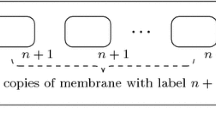Abstract
P systems are a class of distributed and parallel computing models inspired by the structure and the functioning of a single cell and complexes of cells. The computational efficiency of P systems with active membranes has been investigated widely with the assumption that the application of rules is completed in exactly one time unit. However, in biological facts, different biological processes may take different times to complete, and the execution time of certain biological process could vary because of external uncontrollable conditions. With this biological motivation, in this work, we solve SAT problem by a family of P systems with active membranes in a time-free manner in the sense that the correctness of the solution does not depend on the precise timing of the involved rules. In such a solution, standard cell division rules for elementary membranes are applied: the newly generated membranes have the same label with their parent membrane. This result answers an open problem formulated in Song et al. (Theor Comput Sci 529:61–68, 2014).




Similar content being viewed by others
References
Alhazov A, Martín-Vide C, Pan L (2003) Solving a PSPACE-complete problem by recognizing P systems with restricted active membranes. Fund Inform 58(2):67–77
Alhazov A, Pan L, Păun Gh (2004) Trading polarizations for labels in P systems with active membranes. Acta Inform 41(2–3):111–144
Cavaliere M, Sburlan D (2005) Time-independent P systems. In: Mauri G, Păun G, Pérez-Jiménez MJ, Rozenberg G, Salomaa A (eds) Membrane computing. Lecture notes in computer science. Springer, Berlin, pp 239–258
Garey MR, Johnson DJ (1979) Computers and intractability: a guide to the theory of NP-completeness. Freeman W.H., San Francisco
Gheorghe M, Păun Gh, Pérez-Jiménez MJ (eds) (2013) Research frontiers of membrane computing: open problems and research topics, section 12, Cavaliere, M.: time-free solutions to hard computational problems. Int J Found Comput Sci 24(5):579–582
Ionescu M, Păun Gh, Yokomori T (2006) Spiking neural P systems. Fund Inform 71(2–3):279–308
Krishna SN, Rama R (1999) A variant of P systems with active membranes: solving NP-complete problems. Rom J Inf Sci Tech 2(4):357–367
Martin-Vide C, Pazos J, Păun Gh, Rodriguez-Patón A (2003) Tissue P systems. Theor Comput Sci 296(2):295–326
Pan L, Martín-Vide C (2005) Solving multidimensional 0–1 knapsack problem by P systems with input and active membranes. J Parallel Distr Com 65:1578–1584
Pan L, Martín-Vide C (2006) Further remark on P systems with active membranes and two polarizations. J Parallel Distr Com 66:867–872
Pan L, Díaz-Pernil D, Pérez-Jiménez MJ (2011) Computation of Ramsey numbers by P systems with active membranes. Int J Found Comput Sci 22(1):29–38
Păun A (2000) On P systems with active membranes. In: Proceedings of the second international conference on unconventional models of computation, London, pp 187–201
Păun Gh (2000) Computing with membranes. J Comput Syst Sci 61(1):108–143 Also in Turku Center for Computer Science-TUCS, Report 208, November 1998
Păun Gh (2001) P systems with active membranes: attacking NP-complete problems. J Auto Lang Comb 6(1):75–90
Păun Gh (2002) Membrane computing: an introduction. Springer, Berlin
Păun Gh, Rozenberg G, Salomaa A (eds) (2010) Handbook of membrane computing. Oxford University Press, Oxford
Rozenberg G, Salomaa A (eds) (1997) Handbook of formal languages, vol 3. Springer, Berlin
Song T, Macías-Ramos LF, Pan L, Pérez-Jiménez MJ (2014) Time-free solution to SAT problem using P systems with active membranes. Theor Comput Sci 529:61–68
Zandron C, Ferretti C, Mauri G (2001) Solving NP-complete problems using P systems with active membranes. In: Antoniou I, Calude CS, Dinneen MJ (eds) Unconventional models of computation, UMC’2K. Springer, New York, pp 289–301
Acknowledgments
This work was supported by National Natural Science Foundation of China (61033003, 91130034, and 61320106005), Ph.D. Programs Foundation of Ministry of Education of China (20100142110072 and 2012014213008), and Natural Science Foundation of Hubei Province (2011CD A027).
Author information
Authors and Affiliations
Corresponding author
Rights and permissions
About this article
Cite this article
Song, B., Song, T. & Pan, L. Time-free solution to SAT problem by P systems with active membranes and standard cell division rules. Nat Comput 14, 673–681 (2015). https://doi.org/10.1007/s11047-014-9471-4
Published:
Issue Date:
DOI: https://doi.org/10.1007/s11047-014-9471-4




